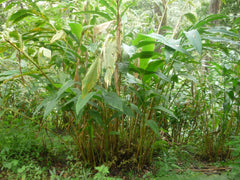
Scientific Name Elettaria Cardamomum
What is Cardamom?
Cardamom is a warm earthy spice commonly used in Indian cooking. It is available in pods, seeds or ground. There are two types of cardamom- Malabar and Mysore. Mysore is warmer and spicier, while Malabar has a eucalyptus flavor.
What is the History of Cardamom?
Cardamom is native to Southern India. It has been used there for over 2,000 years. It was brought to Europe along the caravan routs and the Vikings took it from Constantinople to Scandinavia.

How is Cardamom Grown?
Cardamom grows well in warm equatorial regions around the world. Cardamom is cultivated in India, Sri Lanka, Tanzania, Vietnam, Papua New Guinea and Guatemala. Cardamom is grown on a tall plant that looks similar to an orchid. The plant can reach 20' in height. The pods are the fruit of the cardamom plant. Fruits are harvested when they are nearly ripened (September- December) and dried in the sun. Pickers must return again and again to the same plant as the fruits ripen.
How Can I Use Cardamom?
Look for green pods and sticky seeds to indicate freshness. Cardamom is used in both sweet and savory foods and is essential to Indian cooking. Combines well with many tiles of vegetables, fruits, carbohydrates and legumes.
Fun Facts
- Scandinavia is the biggest importer of Cardamom in Europe.
- Cardamom is the signature note in the Chai Masalas in India.
- Cardamom is a member of the Ginger family.
- Cardamom is the third most expensive spice after Saffron and Vanilla.
Sources
Herbs and Spices by Jill Norman
The Drunken Botanist by Amy Stewart
World Spice at Home by Amanda Bevill and Julie Kramis Hearne


